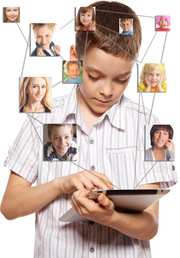10 Apps and Sites Parents Should Add to Child’s Block List
The virtual world is a constant source of dangers and challenges, especially if the users are children. Therefore, parents should always be aware of their actions and take the proper measurements to protect them. Blocking harmful social media apps is one of key ways to prevent kids from engaging online in an unsafe manner.
Without using third party parental controls, there are ways to engage blocking for both apps and websites. However, these types of restrictions can be reset by your kids. Therefore, you’ll need to have a level of trust between you and your child. You can always check their phone from time to time to ensure blocking is still in place.
This article does not provide instructions on how to create block lists on a phone or tablet. Google “how to block apps” for iPhone or Andriods to get instructions within each of the phones settings. In the meantime, here are the top sites that are considered dangerous to be used by children:
1. TikTok
While TikTok is a fun site to spend time and interact with people, there are certainly some dangers associated with this app, which include:
- Inappropriate Content: As an open platform, anyone can post all kinds of content on TikTok, including adult themes, violence, or other indecent content.
- Cyberbullying: Users interact with each other constantly, which can often lead to cyberbullying.
- Privacy Concerns: TikTok collects personal information from its users, which can be used for advertising or shared with third-party advertisers.
- Addiction: TikTok is designed to be addictive, and children spend hours scrolling through videos without even realizing how much time has passed. This interferes with their schoolwork and overall well-being.
- Online Strangers: Children may be drawn into inappropriate conversations or take up with someone who is not who they claim to be.
2. Twitter
While there are some great advantages to using Twitter, including staying up-to-date on the news and connecting with people, there are also some serious risks that parents need to be aware of. Inappropriate or unwanted content on Twitter can take many forms, including exposure to adult content and cyberbullying.
3. Mastodon
Though Mastodon can an easy way for people to connect with like minded people, it has great potential for danger because these online communities are unmonitored. It’s an open source social network, so there are no controls in place to monitor or prevent harmful associations or content. It’s only safe if the creator a community your child joins can be trusted.
4. Roblox
Roblox isn’t just a game–it’s a massive online platform with millions of users. And like any large social media platform or online game, there are risks. But by being aware of the dangers and taking some proactive steps, you can help keep your child safe while they enjoy all that Roblox offers.
5. Ask.fm
Ask.fm is a somewhat unknown social media site to parents. It allows users to ask and answer questions anonymously. Even though interacting with others can be fun and engaging, it also poses risks to children. Anonymity can make it easier for bullies to target others without fear of consequences. Users can receive hurtful comments and messages, and in some cases, cyberbullying has even led to suicide.
6. Toomics
Toomics is a webtoon platform with many online comics and graphic novels. While it can be an enjoyable and engaging platform for readers, some of the comics on the site feature explicit material and depictions of violence. In some cases, the content may be illegal or inappropriate for minors.
To prevent these risks, parents should monitor their children’s use of Toomics and have open conversations about online safety.
7. Reddit
Reddit is a great platform to share information and build a community, yet it is another not-too-safe app for children. One of the primary risks associated with it is exposure to adult content. Some subreddits contain explicit material which users of any age can easily access. This content can include pornography, graphic images, and discussions of sexually explicit topics.
Reddit allows for anonymous posting, allowing users to engage in bullying without fear of reprisal. This can include hurtful comments, trolling, and other negative behavior.
8. Snapchat
Snapchat is known for its disappearing messages and photos, which can lead children to believe that their actions will not have consequences. They can share inappropriate content with their friends.
The temporary nature of Snapchat’s messages can make it easier for predators to approach children. They may use the app to send inappropriate messages or images and quickly delete them to avoid detection. Children are more likely to accept friend requests from strangers on Snapchat, which can put them at risk.
Snapchat has a feature called Snap Map, which allows users to see the location of their friends on a map. This is dangerous for children, as it can reveal their whereabouts to potentially dangerous individuals.
9. Discord
Discord allows users to communicate through voice, text, and video chat. While it’s useful for gamers and others who want to connect with like-minded individuals, it has the potential for cyberbullying. Discord has chat rooms and servers that anyone can create and moderate, making it easier for users to engage in bullying.
Another risk of Discord is exposure to explicit content. Although Discord has rules against explicit content, it’s still possible for users to share inappropriate images or videos.
10. YouTube
While YouTube is a useful and engaging platform for users of all ages, it poses several dangers for children.
Using YouTube is an exposure to inappropriate content. Although YouTube has content filters and age restrictions in place, it’s still possible for children to stumble upon videos that contain explicit material or depictions of violence. This includes content that is not appropriate for their age, such as horror movies, sexual content and depictions of dangerous or harmful behavior.
YouTube comment sections can be a breeding ground for negative behavior, with users leaving hurtful comments or engaging in trolling. Children can be particularly vulnerable to these kinds of attacks and may be unable to handle them.
Conclusion
Parents know how important it is to protect their children from online danger. From cyberbullying platforms to explicit content, the 10 sites featured in this blog post are essential additions to any child’s block list. Parents can protect their children against tremendous danger and damage scrolling in the virtual world by doing so.
Author’s Bio: With years of experience in the cyber security industry, Sophia has devoted a part of her time to writing articles that educate parents about the importance of their children’s online safety. Children of all ages, especially those in elementary and high schools, are constantly exposed to new technologies. Through her writings, she aspires to make a positive impact on their lives by helping parents identify and avoid potential dangers.




